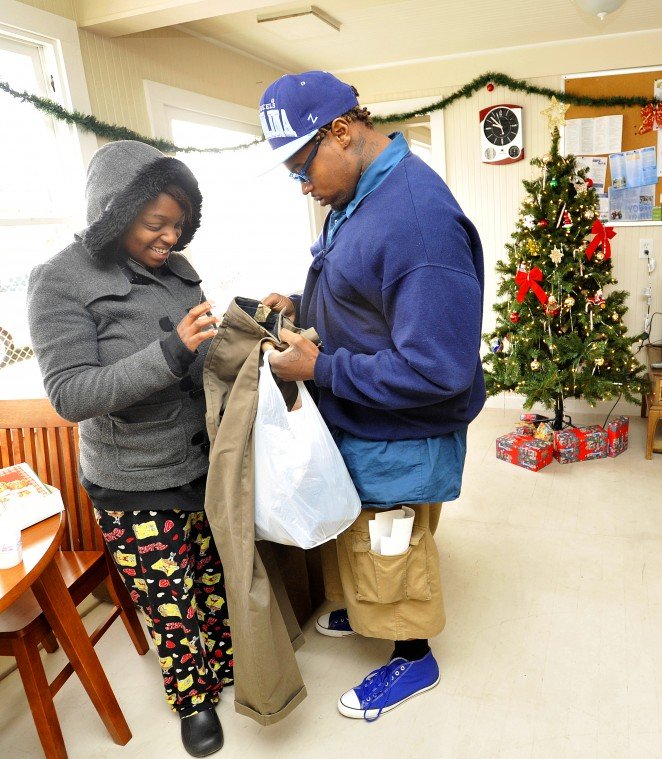Freezing temperatures bite at the nose, ears and cheeks around 6 a.m. as Austin Guess, a homeless 26-year-old, shuffles down Wren Avenue on his 15-minute trek to McDonald’s on First Street.
En route, glowing houses festooned in Christmas lights illuminate the otherwise dark and empty sidewalk. Animatronic reindeer grazing on a frosted front lawn move their sparkly, robotic heads in the silent hours of Tuesday morning.
“It’s awful. It’s not comfortable to be out here at 6 a.m.” says Guess between yawns. “It’s not the best conditions to start the day off with. You’ll find there’s going to be a lot of people out here at this hour.”
Drawing his left hand from a jacket pocket every few minutes, Guess opens his palm and glances at a fistful of change. A knapsack stuffed to capacity is strapped to his back.
After getting kicked out of his father’s house in Sacramento at age 23, Guess lost his custodial job at a hospital after his employers discovered he was sleeping there at night. He eventually gave up looking for work in the Bay Area and headed down to Gilroy last year to stay at the National Guard Armory, which is open seasonally.
Guess was one of dozens trickling out of the Armory on 8490 Wren Ave. – which wakes its overnight occupants at 5 a.m. He rides out the cold most mornings with a cup of coffee at McDonald’s. The staff there is very kind, he said.
Filing out of the building Tuesday just before Guess, one middle-aged husband and his wife, who declined to give their names, said they drive their children to a storage unit Monday through Friday to get dressed and ready for school.
When asked how long his family has been coming to the Armory, the father replied, “too long.”
The National Guard’s homeless program offers a hot meal, shower facilities and sleeping quarters, but is only open from 6 p.m. to 6 a.m. Nov. 28 through March 31. Supporters of the Gilroy Compassion Center – a grassroots outreach organization offering food, clothes, shelter and support services – hope to mitigate the displaced downtime by eventually becoming a year-round homeless shelter open day and night.
Having recently established hours from 9 a.m. to 1 p.m., Center Board Director Jan Bernstein-Chargin said volunteers are still needed from 6 a.m. to 9 a.m. to make and serve coffee, staff the front desk and provide information inside the large, corrugated tin warehouse located at 8425 Monterey Road on the northwest corner of Monterey and Leavesley roads.
The Center is currently staffed with three volunteers, and receives about 15 visitors per day. Having barely advertised its new hours, however, Chargin expects that number to climb quickly.
It’s been almost a year since a large portion of the 42,500-square-foot space was donated rent-free for five years by building owner Jim Currier, a local business owner and National Guard volunteer who teamed up with Chargin to kick-start the endeavor. The goal is to offer a full spectrum of services, from the immediately tangible such as clothes, food, toiletries, a place to rest, make a phone call or do free laundry – to support that yields long-term results, including direct access to social services, housing, career and mental health representatives.
The Center is faced with immediate hurdles, such as the need for $70,000 worth of fire sprinklers (nobody can stay at the center overnight until this is taken care of), in addition to some $300,000 to $400,000 in ongoing internal and external upgrades. As for a complete list of construction needs and cost specifics, Chargin is still waiting on a report from a structural engineer.
The facility, built in 1943 and used for manufacturing war tanks – and more recently as a practice space for the South County Derby Girls – is slowly evolving.
New bathrooms, administrative offices, a reception space and designated rest areas where children and adults can play, read, take a nap and eventually watch TV highlight recent renovations.
Bringing an armful of toys to a little girl who played in the Compassion Center’s reception area Dec. 7 as her mother registered for services, volunteer Alice Lamson pointed out, “People can come be here during the day, and just have some sense of normalcy.”
Explaining how other federal assistance programs such as Calworks and Aid to Families with Dependent Children (AFDC) have become “desensitized” due to sheer volume of clients, the Center’s volunteer manager Cherie Appleby, 41, underlined the goal of becoming a comprehensive establishment that aids not only the homeless, but those with emotional and resource needs.
“Deodorant is gold. I used to have to steal it from 7/11,” said Appleby, who at 15 was “as homeless as it gets.”
Having experienced this lifestyle firsthand, Appleby, who pointed out “I’m not just some person behind a desk doing my job,” said she resonates with the people she serves.
Appleby recalled one particular occasion where a visitor began to cry as she talked about her son, who was having trouble with his parole officer.
“She just wanted somebody to listen to her,” said Appleby. “That’s the whole point of ‘compassion.’ ”
While scraping up funding is a constant variable for the 501(c)(3) nonprofit, Appleby said an orchestra of 20 to 30 volunteers and community partners “hooked” on helping are filling in the cracks: From a growing wardrobe of clothing brought in by donors, to brand-new couches gifted by Rosso’s Furniture, to Gilroy’s Center for Employment Training construction students, who will get on-the-job experience by helping out with renovation projects – Appleby said people are stepping up.
This includes Gilroyan Stephanie Woehrmann, 41, the contracted Center Administrator of the Gilroy Arts Alliance who recently began filming a series of videos documenting Gilroy’s “serious” need of a full-time, year-round, homeless shelter. The ongoing installments titled “El Teatro Compassion” on YouTube capture life on the streets, rural encampments and long lines forming at St. Joseph’s Family Center for food assistance. The footage will become a social tool to generate interest, spark dialogue and perhaps get posted on the Compassion Center’s website, she said.
“I’m thinking there’s a good chance there’s a lot of people in the community who have an idea of why a person is homeless, but they haven’t really been confronted by it,” said Woehrmann, who, currently employed part-time, added “I’m not too many steps away from having to seek services like that.”
“It was 27 degrees this morning at 7:30 a.m.,” she noted over the phone last week. “We need this shelter. If people don’t think we need it, I challenge them to spend the whole night outside.”
While the City of Gilroy hasn’t committed to any long-term funding aid for the Center, Marilyn Roaf, City Housing and Community Development Coordinator, said the city has $21,000 in its housing trust fund for homeless outreach. Local nonprofit agencies are eligible to apply, although the Compassion Center clearly matches the candidate profile.
According to Roaf, the request for proposals should come “from nonprofit agencies to provide one stop services and resources to homeless Gilroy residents and those at risk of homelessness, including ongoing day services and Project Homeless Connect events.”
No one has applied; although Chargin confirmed the Compassion Center is putting together its proposal. A $21,000 grant would help them get the center open by 6 a.m., she said.
Shuffling slowly down Wren Avenue Tuesday morning, Guess agreed the Center’s extended hours would greatly benefit the community. He underscored the often strained relationship between the homeless and non-homeless.
“I’m sure people would head there,” he said. “And it would be easier on the public.”
Since the Armory opened Nov. 28, Sgt. Jorje Monroy, who works there, said he’s noticed an increase in young teen-agers and whole families.
“It’s not even the first two weeks, and I’ve already seen around eight children, as opposed to last year, when I saw two,” he noted.
During its first two weeks of seasonal operation, Monroy said the Armory’s turnout per night ranges from 45 to 65 people. By the third week, that number can spike to 120 or 130, he said.
“It’s sad,” said Guess, of the folks who line up outside the Armory every day at 5:30 p.m. for a hot meal and place to sleep. “But it’s better than being stuck outside.”
For the 2003 high school graduate who hopes to enroll in Gavilan College or San Jose State University to study math, the Compassion Center could be more than a Band-Aid. Guess also said he likes to volunteer there.
“It’s a terrible condition,” he said, of living on the streets. “(The Compassion Center) is a chance to re-gather yourself and look for work and education.”
– The Compassion Center is located at 8425 Monterey Road on thenorthwest corner of Monterey and Leavesley roads
– In-demand supplies include donations of women’s jackets andjob interview appropriate clothing, plus new or gently used men’sworkshirts and jackets, especially in L, XL, and XXL sizes.
– Donations can be made out to the Gilroy Compassion Center,P.O. Box 233, Gilroy, CA 95021.
– Visit: gccsoco.org














